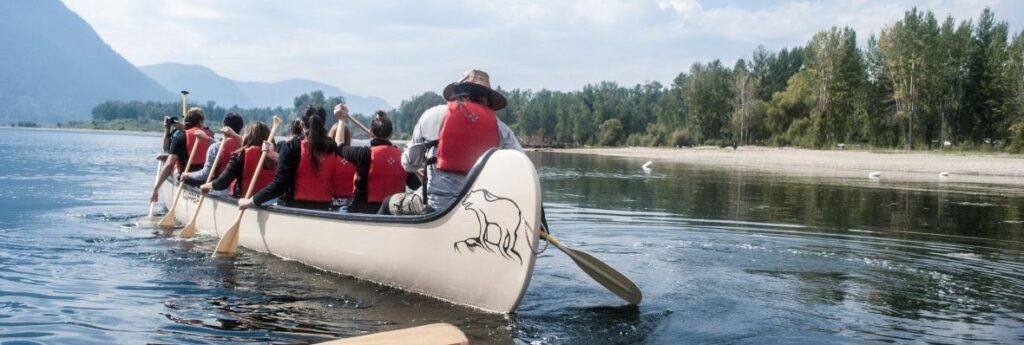“Building Back Better” was the theme of the recent three-day National Indigenous Tourism Conference in Calgary, which largely took stock of an industry that has taken a significant beating the past couple of years due to the COVID-19 pandemic, but is cautiously looking to the future.
Indigenous businesses suffered greater than some others in the tourism sector in part because many Indigenous communities across Canada had their own lockdowns and restrictions, prohibiting visitors.
“We want to make sure we can rebuild because we are resilient,” said Sebastien Desnoyers-Picard, chief marketing officer of the Indigenous Tourism Association of Canada (ITAC) during the conference’s keynote address. “Our communities are strong. Our people are even stronger. And I want to make sure that we highlight that, and we continue in that same sense and the same spirit of showcasing, highlighting, and sharing our culture to the world.”
Desnoyers-Picard and his ITAC colleagues are keen to play a significant role in the bounce-back.
“As soon as international travel restrictions are lifted, ITAC will continue to lead Indigenous tourism industry into the resiliency phase,” he said. “Our objective really is to hit and bring back all the 2019 numbers and rebuild the industry by 2025 or 2026.”
Previous estimates, however, have suggested could take longer, possibility 2028, lagging behind Canada’s general tourism recovery.
In 2019, the year before the COVID-19 pandemic started having major impacts in Canada, about 39,000 people were employed in Indigenous tourism jobs across the country. Today, just over half of those jobs are around.
As part of their three-year strategic plan, from 2022 through to 2025, ITAC officials are asking the federal government for a $65-million investment over those years.
“We want to bring back roughly 21,000 jobs,” said ITAC’s CEO and president Keith Henry. “That’s what it’s going to take to get us back to the 39,000 or so level of jobs, full- and part-time.”
Henry said ITAC officials are hoping about 4,200 jobs are regained in 2022. And then 8,400 more are gained in each of the following two years. ITAC officials are waiting to see how much funding they will receive when the 2022 federal budget is unveiled next month.
“The truth is if we don’t see those kinds of strategic investments, we don’t know how the industry will grow fast enough,” he said. “There’s not enough marketing in our opinion, enough drive, enough tools in the toolkit to actually drive more customers, whether it’s Canadians domestically or as we re-enter international markets.”
Destination Canada
One positive development was Destination Canada renewal at the conference of its long-standing partnership with ITAC, which will include:
• A minimum of $1 million in-kind support for promotion in the US and other international markets
• $1.6M for Indigenous-led content creation by ITAC
• $400K for content distribution domestically
• $150K to enhance the Indigenous participation at Rendez-vous Canada (RVC)
• $50K for the National Indigenous Tourism Conference (NITC)
• And a commitment to continue to work together with ITAC to share and develop knowledge, complementary expertise, and market intelligence.
“The Indigenous tourism experiences available here for Canadian and international travellers are unique in the world,” said tourism minister Randy Boissonnault. “It is through respect and partnership that we will ensure that Indigenous tourism not only recovers from the pandemic but meets its impressive growth potential.”
The $3.2-million investment is designed to help to support the recovery and growth of a sector of the tourism industry that contributed an estimated $1.9 billion in revenue to Canada’s gross domestic product.
Destination Canada CEO Marsha Walden said, “We know that demand for truly authentic Indigenous experiences is rapidly growing for both domestic and international travellers. Our work with ITAC will help strengthen the Indigenous tourism industry so that they can capture the recovery opportunity that lies ahead.”
“What’s most important about this agreement is the positive effect it will have on Indigenous tourism businesses across Canada as they rebuild,” said Henry. “Working in collaboration with powerful organizations like Destination Canada we hope will inspire continued collaboration between Indigenous organizations and provincial and national tourism associations across Canada.
“Where tourism is welcomed by Indigenous peoples, it has the potential to create significant economic and social benefits as well as meaningfully support reconciliation through revitalization and sharing of languages, music, cuisine, arts, and culture – with both Canadians and world travellers.
Henry said plenty of consumer research has been done in the past 24 months suggesting “There’s a change in the way people look at this planet. And the truth is more than ever they want to understand Indigenous culture and values because people fundamentally believe this planet is not savable unless we do. That’s an advantage for this industry.”
Parks Canada
Brady Smith, ITAC’s chief strategy officer, believes the association needs to leverage its partnerships to succeed and grow.
Another one of those is Parks Canada, which like Destination Canada renewed its partnership with ITAC at the conference.
Parks Canada and ITAC reps will work together to support, develop, and market authentic Indigenous tourism experiences in locations administered by Parks Canada and in surrounding areas. The agreement runs through to the end of 2025.
“Parks Canada recognizes that working in partnership with Indigenous peoples is critical to the protection of national historic sites, national parks, and national marine conservation areas and the sharing of the stories of these treasured places,” said organization president and CEO Ron Hallman.
It’s also a chance to further advance understanding and reconciliation.
Prior to the pandemic Parks Canada was welcoming between upwards of 25 million visitors a year. “So, each visit can become one small act of reconciliation for one person in Canada or from locations around the world,” Hallman said.

